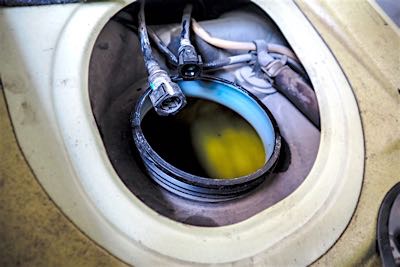
Just this summer, I experienced a situation in which the fuel pump had been replaced four different times on a single vehicle with no result because the various repair shops attempting to repair the vehicle didn’t understand how to diagnose a pulse-modulated fuel delivery system. Instead of a defective fuel pump, the problem was caused by a defective electronic fuel pump control module (FPCM). Here are five things you should know about pulse-modulated fuel delivery systems:
1. Supply and Demand
Conventional electric fuel pumps constantly operate at 100 percent capacity, which wears the fuel pump out relatively early in the vehicle’s life. To remedy this situation and establish more accurate fuel control, engineers designed a fuel pump that runs on electrical impulses rather than a steady current. Running the fuel pump on electrical impulses not only allows the Powertrain Control Module (PCM) to control fuel pump speed and pressure according to engine demand, it also extends fuel pump life and reliability.
2. System Identification
Pulse-modulated systems can be identified because they generally have no external Schrader valve port for testing fuel pressure. Instead, when the technician connects his professional scan tool, he will usually see fuel pressure as a data display transmitted from an electronic fuel pressure sensor located on the fuel injector manifold or “rail.” In addition, he will observe the “duty cycle” or the length of pulse modulation available at the fuel pump.

3. Pulse Modulation Principles
The basic operating principles of pulse-modulated fuel pumps are relatively simple. When the PCM senses that the engine is demanding more fuel, it commands another key component, the fuel pump control module (FCM), to increase the fuel pump speed by increasing the length of the electrical pulses being sent to the fuel pump. Similarly, when the engine’s fuel demand decreases, the length of the electrical pulses sent to the fuel pump is decreased. Electronically managing the fuel pump speed and fuel pressure through pulse modulation is a convenient method for helping the fuel injectors efficiently meet minimum and maximum fuel demands.
4. Fuel Delivery Diagnostics
Most failures in a pulse-modulated fuel system are instantly recognized by the on-board diagnostics built into the engine’s PCM. The on-board diagnostic process is relatively simple. When the PCM senses that a longer-than-usual pulse width is required to meet a commanded fuel pressure value, it stores one or more DTCs in its diagnostic memory indicating that the fuel pump isn’t performing at its commanded level. Keep in mind, of course, that common failures such as a restricted external or in-tank fuel filter or pinched fuel line also can store these and other trouble codes in the PCM’s diagnostic memory.
5. Selling Pulse-Modulated Parts
Pulse-modulated systems can be accurately diagnosed only by using a professional scan tool to recover DTCs and perform specified testing procedures, such as bi-directional pump control.
Article courtesy Underhood Service.














